
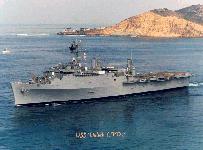

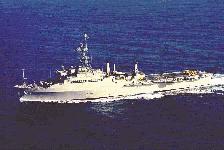
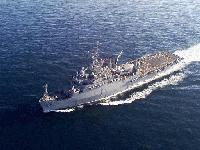
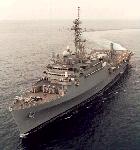
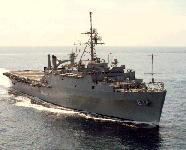
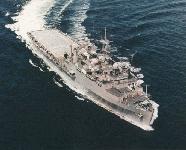
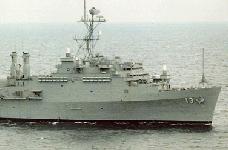
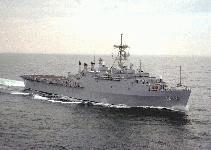
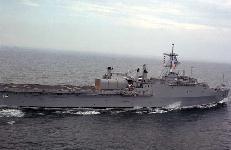
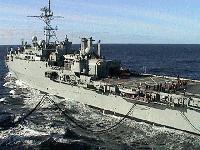
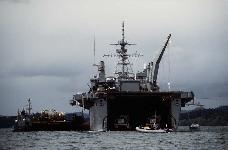
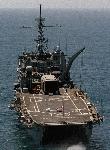

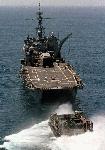
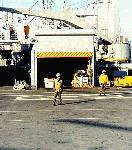

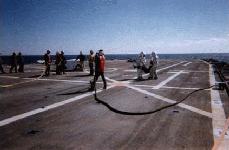
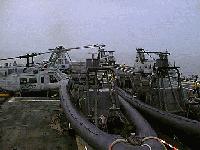



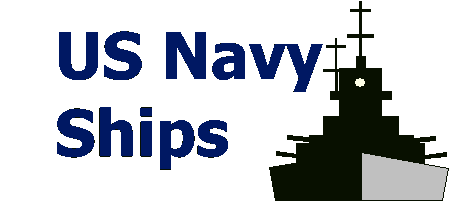
These ships are configured as a flagship and provide extensive command, control and communications facilities to support an Amphibious Task Force Commander and Landing Force Commander. In an amphibious assault, the ship would normally function as the Primary Control Ship that would be responsible for coordinating boat waves and vectoring landing craft to the beach.
A secondary mission is evacuation and civilian disaster relief. Hundreds of tons of relief materials can be carried aboard and can be delivered to disaster victims within minutes of the ship's arrival on the scene. The ships' medical and dental facilities can provide limited hospitalization care, as well as out-patient treatment for hundreds of sick or injured. USS SHREVEPORT departed Norfolk VA on June 8, 1998 as for Exercise MARCOT/Unified Spirit. SHREVEPORT, acting as Advanced Force Command ship, along with several other ships, was a test platform for the new Joint Countermine Application (JCA). JCA is a JMCIS application being developed to support all aspects of countermine warfare. The JCA’s functions include collection and distribution of the mine countermeasure picture, allowing units to receive and analyze data. The ships have has a large flight deck for helicopter operations and a well deck that carries amphibious landing vehicles. The ships can carry one landing craft air cushion (LCAC), or one utility landing craft (LCU) boat, or four mechanized landing craft (LCU), and six CH-46 amphibious transport helicopters, or three CH-53 helicopters, and over 800 combat troops. They can also cary 2,000 tons of supplies and equipment, all in addition to her crew of 400 officers and enlisted men. The LPD 4 Austin class has a helicopter platform built over a well deck in the rear of the vessel. This provides the tactical advantage of being able to lift troops, their combat equipment and supplies onto the same ship. Therefore, the ship contributes to all phases of the amphibious assault. The well decks are upper and lower vehicle storage areas, which hold most of the embarked troops' heavy combat equipment, such as tanks, tracked amphibious landing vehicles (AAV), jeeps and trucks. The well deck is capable of holding one (1) LCU or one (1) LCAC and two (2) LARC-5. A mix of LCM-8 and LCM-6 is possible up to four (4) LCM-8 or two (2) LCM-8 and three (3) LCM-6. To facilitate the docking and loading of various sized landing craft, the ship can ballast down in the water, thereby flooding the well deck with enough water to enable the landing craft to enter the well deck through the stern gate door. Once docked inside the well deck, troops, supplies and combat equipment can be loaded into or off of the amphibious boats and vehicles while simultaneously transporting troops and equipment via helicopter from the flight deck.The ships can simultaneously land or launch two (2) H-1, H-2 , H-3, CH-46, CH-53 type aircraft from the landing spots on the flight deck. The ship is certified for expanded flight deck operations and four (4) H-1 or two (2) H-1 and one (1) H-46 type aircraft can be on deck and turning at the same time. All helicopters will be launched or landed one at a time. One AV-8 can be landed under VFR conditions during daylight hours only.
Propulsion consists of two Foster Wheeler 600 psi boilers, powering two De Laval GT turbines, driving two propellers, providing 12,000 Shaft Horsepower (SHP) each. The four electrical power generators, which are powered by the steam from the boilers, can generate enough electricity to power a city of 26,000 people. The ships have laundry and pressing services, barbershop, ship's store, disbursing, administration, post office, library, welding shop, machinery repair shop, valve shop, diesel engine repair shop, AC&R shop, two evaporators capable of 25,000 gallons of water a day, each. The ships have their own doctor and dentists, with a twelve bed medical ward, bacteriological laboratory, X-ray facilities, sterilizing room and dental operatory. Storerooms and refrigerated spaces, can subsist 1,500 crew members for 60 days, or 500 men for 90 days.
Specifications | |
| Power plant | Two boilers, two steam turbines, two shafts, 24,000 shaft horsepower |
| Length |
Overall Length: 569 ft Waterline Length: 548 ft |
| Beam | Extreme Beam: 105 ft Waterline Beam: 84 ft |
| Draft |
Maximum Navigational Draft: 22 ft Draft Limit: 23 ft Ballasted: 34 feet |
| Displacement |
Light Displacement: 9201 tons Full Displacement: 16914 tons Dead Weight: 7713 tons |
| Speed | 21 knots (24.2 mph, 38.7 kph) |
| Aircraft | Up to six CH-46 Sea Knight helicopters |
| Well Deck Capacity: |
1 - Landing Craft, Air Cushion (LCAC), or 1 - Landing Craft, Utility (LCU), or 4 - LCM-8 Landing Craft, Mechanized (LCM), or 9 - LCM-6 Landing Craft, Mechanized (LCM), or 24 AAV Amphibious Assault Vehicle |
| Crew |
Ship's Company: 420 (24 officers, 396 enlisted) Marine Detachment: 900 |
| Combat Systems |
SPS-40 - Air Search Radar SPS-60 - Surface Search Radar SPS-64 - Navigational Radar Furuno - Navigational Radar |
| Armament |
2 - 25mm Mk 38 guns 2 - Phalanx CIWS 8 - .50-calibre machine guns. |
| Unit cost | $235-419 million |
| Unit Operating Cost Annual Average | ~$22,500,000 [source: [FY1996 VAMOSC] |
Ships | |||||||
| Name | Number | Builder | Homeport | Ordered | Commissioned | Decommissioned | |
| Austin | LPD 4 | NYNSY | Norfolk | 21 Sep 1961 | 06 Feb 1965 | ~2003 | |
| Ogden | LPD 5 | NYNSY | San Diego | 21 Sep 1961 | 23 Sep 1965 | ~2004 | |
| Duluth | LPD 6 | NYNSY | San Diego | 21 Sep 1961 | 31 Jan 1966 | ~2004 | |
| Cleveland | LPD 7 | Ingalls | San Diego | 25 Jan 1963 | 03 Apr 1967 | ~2005 | |
| Dubuque | LPD 8 | Ingalls | San Diego | 25 Jan 1963 | 21 Aug 1967 | ~2005 | |
| Denver | LPD 9 | Lockheed | San Diego | 23 May 1963 | 18 Oct 1968 | ~2006 | |
| Juneau | LPD 10 | Lockheed | Sasebo | 23 May 1963 | 07 Jul 1969 | ~2006 | |
| Coronado | AGF-11 | Lockheed | |||||
| Shreveport | LPD 12 | Lockheed | Norfolk | 15 May 1964 | 01 Dec 1970 | ~2007 | |
| Nashville | LPD 13 | Lockheed | Norfolk | 15 May 1964 | 26 Dec 1969 | ~2007 | |
| Trenton | LPD 14 | Lockheed | Norfolk | 17 May 1965 | 12 Feb 1971 | ~2008 | |
| Ponce | LPD 15 | Lockheed | Norfolk | 17 May 1965 | 25 Jun 1971 | ~2008 | |
| LPD 16 | 1966 | CANCELLED Feb 1969 | |||||



















